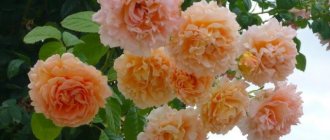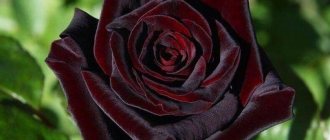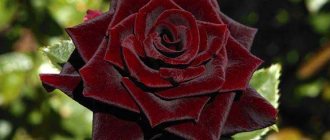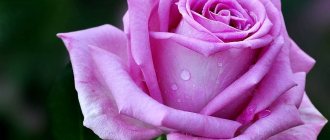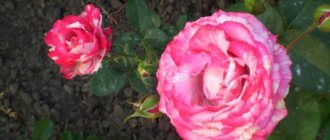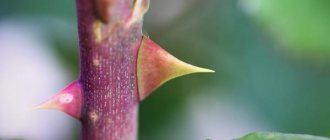Rose Abraham Darby: description + photo
The variety was obtained in 1965 by crossing two varieties:
- polyanthus yellow rose Yellow Cushion;
- climbing pink-red rose Aloha.
The resulting result went on sale under several names in addition to Abraham Derby: AUScot, Candy Rain, Country Darby.
General information about Austin roses
All varieties of roses, bred by British breeder David Austin, are perennial shrubs and stand apart from other similar flowers. The bushes of these plants are tall with erect shoots about 1.5 m long and higher, the buds have a classic goblet shape and a delicate original aroma, inherent in all varieties bred by this breeder.
David Austin decided to “reanimate” old varieties of bush “queens of flowers”; his goal was to use them to develop plants that would be highly resistant to diseases, would bloom several times per season, would have beautiful shapes, and could grow in regions with different climatic conditions. conditions, and the flowers would be beautiful and have a pleasant aroma. In addition, this breeder sought to develop roses whose bud petals would be yellow or orange in color.
Rose Abraham Derby
Almost all varieties bred by Austin are still popular among flower growers and gardeners in most countries of the world, despite the fact that more than half a century has passed since the appearance of these varieties.
The Abraham Derby variety was bred in 1965, its “parents” were the polyanthus rose Yellow Cushion, the flower petals of which have an intense yellow color, and the climbing double rose Aloha, the color of the buds is pink with a red tint.
Interesting! Natural oil made from rose petals is one of the most expensive and valuable in world cosmetology. To get just a liter of this valuable product, more than 3 tons of freshly picked petals are required.
The flowers of the English rose Abraham Derby are densely double and have a classic cup-shaped shape, which is characteristic of all bush “queens of flowers”. The color of the bud petals in the central part is soft pink, and the outer petals are yellow. The originality and unusualness of these flowers is that they can change color depending on climatic conditions. These flowers are like chameleons, they can start out pink with a slight hint of yellow and then change color to a soft peach.
History of selection
The Abraham Derby variety was developed in 1965 in England. The breeder is the famous British breeder David Austin. He developed more than 150 new ornamental varieties, most of which are actively cultivated by gardeners around the world.
Rose David Austin Abraham Derby is the result of interspecific crossing. During breeding work, the varieties Aloha and Yellow Cushion were used.
The rose is named after British metallurgist Abraham Derby III, who is famous for building the world's first cast iron arch bridge. This building is located near the breeding station where David Austin worked.
Short description
The double flower of 70 petals has a classic cup-shaped shape for old park roses. The petals are colored copper-apricot in the central part of the corolla, and pink closer to the edges. A powerful bush with a height of 1.2 to 3.05 m can be pruned into a compact and rounded bush, up to 1.5 m in diameter. Or you can give it the appearance of a climbing rose. But in any case, the rose bush will be strewn with flowers.
The foliage is abundant, green, shiny. Flowering occurs in alternating long waves.
Rose corollas are changeable in color. In the heat, their shade becomes apricot, and in cool weather it turns into a rich pink. Shedding is reluctant. Among English roses, Abraham Derby is considered the largest; its buds in full bloom reach 15 cm in diameter.
Forcing occurs at the ends of annual shoots in clusters of 1-3 flowers. The strongest aroma has typical rose, strawberry and fruity notes.
Note! The prickliness of this variety is medium. Therefore, when caring for a rose bush, it is advisable to wear gloves made of thick material.
Description of the bush
Rose Abraham Derby often grows as a shrub, but in warm climates it can produce lashes up to 2 meters. If there is support, this variety can be used as a climbing variety, especially since some of its flowers turn downwards under their own weight and this height is most comfortable for perception. Most gardeners will be content with more modest sizes: the maximum height will not exceed 120-150 cm, and the width of the bush will be within 1 meter.
The reddish shoots of Abraham Derby are very prickly, but they bend well and are elastic enough to withstand even strong gusts of wind. The foliage is dark green, shiny and remains that way all season until frost.
Features of the variety
Rose Abraham Darby is a tall, lush and rounded perennial shrub, the length of erect shoots reaches 1.5 m. If the Abraham rose is well cared for and the climatic conditions are favorable, then the stems can reach a height of more than 2.4 m.
Derby rose, bred by the British breeder Austin, grows very actively, so in the park area it is often used as a climbing plant. Up to three buds can form simultaneously on one shoot.
Rose Abraham Derby
The buds of this rose are double, fully bloomed buds in a radius can be up to 7 cm. These perennial bushes bloom from the first ten days of June until the last ten days of September, and new buds appear continuously. To ensure active and abundant flowering, it is recommended to constantly remove fading flowers. The aroma of this rose is rich fruity with a predominant scent of lemon.
But this variety has average resistance to various diseases characteristic of rose bushes, as well as to attacks by “harmful” bugs. Also, the Abraham rose reacts very poorly to the rainy season - in such weather, new flowers do not appear, and buds do not bloom.
Features of growth
The rose grows quickly and is often used as a climbing plant. On one stem of Abraham Derby there are usually about three flowers up to 14 centimeters in size. The variety is considered to be bushy and is moderately resistant to infections and insects.
The rose blooms for a long time: from the first days of summer until the end of September. At this time, the garden is filled with a bright aroma with light notes of citrus. However, precipitation causes the buds to shrink and do not open until the rain stops.
Origin of the variety
The variety was bred in 1985 by the famous breeder David Austin in the UK and registered under the name AUScot. The flower received the name “Abraham Derby” in honor of the English industrialist, designer and metallurgist, creator of the metal bridge, which is located a few kilometers from the David Austin family nursery.
Abraham Darby was the result of crossing two modern roses: the floribunda Yellow Cushion and the climbing Aloha, which in itself is unique, since David Austin uses mainly old garden varieties in his breeding work.
Modern varieties were used as parent forms: Yellow Cushion (pictured left) and Aloha (right)
The exceptional qualities and worldwide popularity of Abraham Darby are confirmed by numerous awards received at international competitions: in 1999 in Salem, Modesto, Los Angeles and Las Vegas, in 2000 in Harrisburg, and in 2001 in Millenn and Augusta (USA).
Characteristics of rose Abraham Derby
The approach to plant classification varies. Some gardeners consider the Abraham Derby rose to be a climbing rose. This is explained by the fact that the Aloha variety, which was used in breeding work, belongs to this category. In fact, the plant does not have long branched vines. Therefore, most nurseries grow the Abraham Derby bush rose, which blooms on the shoots of the current year.
The variety is classified as a park variety. The plant is a medium-sized ornamental shrub. Height - from 60 cm to 1.5 m. Under favorable conditions, the bush reaches 2.5-3 m.
The plant is highly branched. The shoots are strong, with a lot of thorns. Late stems are prone to lignification. The bark is soft, dark green with a purple tint.
Surface shoots are covered with dense foliage. The plates are ovoid, up to 8 cm long. Yellowish veins are clearly visible on the leaves.
During the flowering period, the rose is covered with large double flowers. They consist of 60-70 petals of various sizes. The shape of the buds is cup-shaped, the diameter reaches 12 cm. The color is soft pink with a yellow-peach core.
The Abraham Derby rose begins to bloom in mid-June.
The buds bloom once. Flowering lasts until early September. Roses change throughout the summer. Therefore, flowering is not interrupted. The plant emits a pleasant, persistent aroma.
The bushes are lush and vigorous. They lend themselves well to shaping. Supports for shoots are used provided that their height exceeds 110 cm.
Important! With abundant flowering, a garter is required so that the shoots do not break under the weight of the buds.
Abraham Derby roses are characterized by early flowering. When planting a seedling in the spring, it may bloom in the summer. The bush grows quite quickly.
Annual growth of shoots – up to 40 cm
The variety is characterized by high frost resistance. The plant tolerates temperatures down to -26 degrees. In central Russia and in the southern regions, roses can be grown without shelter for the winter. Frost protection is required in Siberia and the Urals, where temperatures can drop lower.
The Abraham Derby variety tolerates short-term drought well. A prolonged lack of moisture has a detrimental effect on the condition of the bush. The buds and foliage wither and gradually fall off.
Rose is sensitive to waterlogging. Prolonged heavy rains and improper watering can seriously damage the bush. Excess moisture is the main cause of disease development, especially black spot and powdery mildew.
Advantages and disadvantages of the variety
The hybrid English rose Abraham Darby has a wide range of positive characteristics and qualities. This explains its popularity among flower growers and landscape designers.
Advantages of the variety:
- compact bush size;
- unique color of buds;
- long flowering;
- frost resistance;
- pleasant aroma;
- good tolerance of prunings;
- low sensitivity to diseases.
The described variety also has negative characteristics. They should be taken into account before planting the plant on your site.
Flaws:
- demanding care;
- deterioration of decorative qualities under unfavorable weather conditions;
- possibility of pest damage;
- sensitivity to nutrient deficiencies.
The Abraham Derby variety cannot be considered one of the most resistant. However, if agricultural techniques are followed, such a plant can be grown without the risk of the bush withering.
English roses by David Austin
While still a teenager, the son of an English farmer, David Austin, became interested in growing roses. A hobby that no one except him took seriously has become his life’s work - for more than 75 years, the enthusiastic breeder has been breeding these luxurious flowers, and his “English roses” are known in all corners of the earth.
David Austin was inspired to create them by antique roses he saw in France. His dream was to breed roses that would combine the appearance of ancient varieties and qualities such as repeated flowering, intense aroma and proportionality of the bush. In addition, Austin decided to expand the color palette, which is very limited in ancient varieties.
His first creation was the rose Constance Spry - the result of a selection of the vintage Gallic Belle Isis and the modern floribunda Le Grice. A tall bush of huge, myrrh-scented flowers created a real sensation in the world of flower growers.
This was followed by many years of breeding work. Vintage flower shape and aroma have always come first for David Austin. Most of its varieties are cup-shaped, pompom-shaped or rosette-shaped and exude a unique scent that is inferior to even the most expensive French perfumes. A number of Austin's creations have been inducted into the World Rose Hall of Fame.
Today, more than 200 varieties of English roses are officially registered, to which several new products are added every year. Some of them Austin produces not for commercial purposes - they will never go on sale. But all the roses of the famous breeder can be seen in his nurseries scattered around the world.
Reproduction methods
The hybrid rose variety Abraham Derby tolerates division well. Therefore, this option is most convenient for those who already have a similar plant. The bush is dug up, cleared of soil and cut into several parts. Each division is planted in a new place. This is the fastest and easiest way to grow another specimen in the garden.
Shoots on divisions need to be trimmed, leaving 12-15 cm from the root collar
Another effective option is cuttings. Separated shoots of roses take root and adapt well to nutritious soil. However, this process takes a long time.
Important! Cuttings are collected in spring or after flowering. They are rooted in a nutrient substrate and planted in open ground in the fall.
Abraham Derby roses can be propagated by layering or suckers. However, such methods are more labor-intensive and are better suited for experienced gardeners.
How to plant correctly in open ground
You can get an excellent result - a strong, profusely flowering rose bush if you follow the basic rules for planting English park roses.
In what form is planting carried out?
It is possible to purchase varietal seedlings exclusively in a specialized nursery, where deliveries are made from European garden centers. The optimal age of planting material is 2-3 years. Such a bush is able to overwinter well and quickly adapt to a new place.
Seedlings with open or closed root systems are available for sale. When purchasing, pay attention to the condition of the shoots and roots. The roots should not be overdried, and there should be no suspicious spots or signs of rot on the shoots. The living root does not crunch or break when bent. Some of the shoots may be woody, but the rest are covered with green bark.
Note! If you don’t want to limit yourself to exact planting dates, you should purchase a seedling with a closed root system in a container.
What time does boarding take place?
Planting is allowed in spring and autumn.
- Spring (in April) is more profitable, since the bush has more time to take root and build up the ground part.
- Autumn (September) planting gives an advantage in root growth, which increases the chances of the first flowering next summer.
Growing rules
Since this variety is not designed for cultivation in the vast expanses of the Russian Federation, gardeners need to take care in advance to create certain conditions. In order to grow a proper and beautiful bush with a lot of flowers, it is important to be careful about planting.
In what form is planting carried out?
It is possible to purchase varietal seedlings exclusively in a specialized nursery, where deliveries are made from European garden centers. The optimal age of planting material is 2-3 years. Such a bush is able to overwinter well and quickly adapt to a new place.
Seedlings with open or closed root systems are available for sale. When purchasing, pay attention to the condition of the shoots and roots. The roots should not be overdried, and there should be no suspicious spots or signs of rot on the shoots. The living root does not crunch or break when bent. Some of the shoots may be woody, but the rest are covered with green bark.
Note! If you don’t want to limit yourself to exact planting dates, you should purchase a seedling with a closed root system in a container.
Landing dates
The Abraham Derby rose variety can be planted both in spring and autumn. Spring seedlings take root better and give the novice gardener the opportunity to observe their development. It is important to get rid of excess buds on the plant before planting, leaving only 5-6. This will allow the bush to devote all its energy to vegetative growth and increase winter hardiness.
When planting, it is recommended to ensure good drainage in the holes and strictly follow the planting pattern. The plant grows both upward and to the sides, so the minimum distance between bushes should be 4 meters.
Selecting a location
The site must be selected carefully. It must meet the following requirements:
- good diffused lighting;
- protection from gusts of wind and drafts;
- elevated location.
A bush planted in a suitable place will bloom profusely.
If there are no hills on the site, it is recommended to raise the soil level by filling them yourself.
Criteria for choosing a seedling
The key to successful establishment of a rose is the correct choice of seedlings. It is recommended to give preference to two to three year old specimens. This is a period of high levels of winter hardiness and vigor, therefore the survival rate increases. It is preferable to choose green stems, without wrinkles or drying out.
Important! Grafted seedlings are many times stronger than the stems on their roots. It is recommended to ask the seller in advance about the propagation method, this will increase the likelihood of good survival.
How to prepare the soil and flower for planting
Before planting, the soil should first be dug well twice - six months before and 4-6 weeks before. Liming is not necessary, but it is recommended to add some organic matter.
When preparing a seedling, you need to cut the stems down to 4-6 buds, remove damaged and dry roots, and sprinkle the cuts with charcoal. After this, the plant is kept in water for 3-4 hours.
Step-by-step boarding procedure
After the preparation is completed, you can begin planting the rose. The sequence will be like this:
- In the selected area, dig a hole 2 shovels deep.
- Drainage is poured into the bottom of the hole, covering it with a layer of nutritious soil on top.
- The seedling is placed in a hole, deepening the root collar 5–6 cm below the ground level and carefully straightening the roots.
- The hole is covered with earth and pressed down with hands.
- The seedling is watered abundantly.
Note! It is advisable to mulch the space around the bush.
Important Tips
- For better growth of the root system, seedlings must be soaked for at least 5-8 hours before planting. The roots in the water straighten well and are saturated with moisture, which improves the transfer of nutrients to the stem.
- Fungicides are added to the water. They prevent fungal diseases and prevent further development of infection.
- After soaking, the root system is thoroughly inspected. Sick, broken and damaged roots are cut off. The rest are pinched 2-3 cm to speed up the growth of the bush.
- The bush is placed in the central part of the hole, the roots are carefully distributed and covered with soil so that there are no voids left. The soil is compacted from above and watered abundantly. Even a small seedling requires at least 5-8 liters of water.
- Within a week, the bush can wither and weaken, so it needs moisture. To preserve it, the soil at the roots is sprinkled with mulch. Small sawdust, freshly cut grass, and hay are suitable.
Propagate by cuttings, layering and dividing the bush
Propagation by cuttings:
| |
Reproduction by layering:
| |
Reproduction by dividing the bush:
|
Subtleties of caring for the variety
In order for the Abraham Derby rose to please the gardener with its appearance and bright aroma, you need to be careful about caring for the variety.
Watering
The plant does not tolerate excessive watering, however, “prohibition” also causes significant damage to the root system. It is optimally recommended to water the Austin flower once every 7-10 days, using up to 10 liters of warm, settled water. In September it is necessary to completely stop watering.
The first feeding is carried out only in the second year of the plant’s life. Predominantly nitrogen fertilizers are used. If animal manure was chosen as a subcrust, it must be allowed to ferment for a week. During the growing season, it is recommended to fertilize the rose with special mineral fertilizers every three weeks.
Fertilizer application
Spring feeding. It is carried out immediately after circumcision or when the buds are swollen. Mullein or special fertilizer for roses is placed around the perimeter of the bush, 10-15 cm thick. During the bud formation stage, the bush can be fed with rotted grass.
Summer feeding. It is carried out after the first flowering, but no later than July 20. Complex fertilizers will help maintain the vigor of the bush. Nitroammophosphate contains three important components - potassium, phosphorus and nitrogen. For one bush, 75 grams of the substance is enough.
Autumn feeding. In early September, the last feeding before winter is carried out. During this period, it is important to enrich the soil with potassium. Up to 15 grams of the substance are scattered per meter. Be sure to stabilize the acidity of the soil with wood ash (1-2 cups). Before filling under the root, the ash must be sifted.
Rose blossom
Rose Olivia Rose - description of varietal shrub
With the right agricultural technology, the Abraham Derby rose will delight you with its magnificent flowers for decades in a row throughout the summer months. At the height of flowering, the aroma of blossoming buds can be clearly heard from a distance of several meters.
- Period of activity and rest
The first flowers open in the first ten days of June. The last of them can be cut off in the last ten days of September.
- Care during and after flowering
To ensure flowering does not stop, it is important not to skip feeding, and be sure to cut off wilted buds, preventing the plant from wasting energy on ripening the seeds.
- What to do if it doesn’t bloom, possible reasons
This effect occurs when planting roses in the shade. If the bush has changed the color of the foliage to yellow-brown, then this indicates an acute lack of iron and magnesium, and urgent feeding is required.
Pests and diseases
The most common diseases of Abraham Derby roses are black spot and powdery mildew. They arise due to waterlogging and violation of the watering regime.
For preventive purposes, the plant should be sprayed with a soap solution. In autumn, in preparation for wintering, the bush is treated with copper sulfate.
In case of powdery mildew, the affected shoots must be removed
Preventive treatment with fungicides is carried out 2 times a year - before flowering and in autumn. This will protect the bush from fungi and bacteria.
Common pests of the English park rose Abraham Derby are:
- aphid;
- slobbering pennies;
- sawfly;
- leaf rollers;
- roseate cicadas;
- spider mites.
The most effective method of insect control is insecticide treatment. It is carried out 2-3 times with an interval of 3-7 days, depending on the properties of the drug.
Pruning rules
The method of pruning Abraham Derby roses depends on the type of cultivation. If it is used as a climbing plant, there is practically no need for pruning. In this case, only shoots that are damaged and have not ripened over the summer are removed. The lashes can grow to a length of 2-2.5 meters.
To obtain a lush, spreading bush, you should lightly trim the frozen ends of the lashes. And if you need a compact bush, you need to prune the shoots by two-thirds annually. This pruning is carried out in the spring.
Advice. Perform pruning only with sharp pruning shears to avoid damaging the bark of the shoots. Make the cut at an angle of 45 degrees from above - above the bud, from below - below it. Be sure to cover the cut areas with garden varnish or oil paint.
